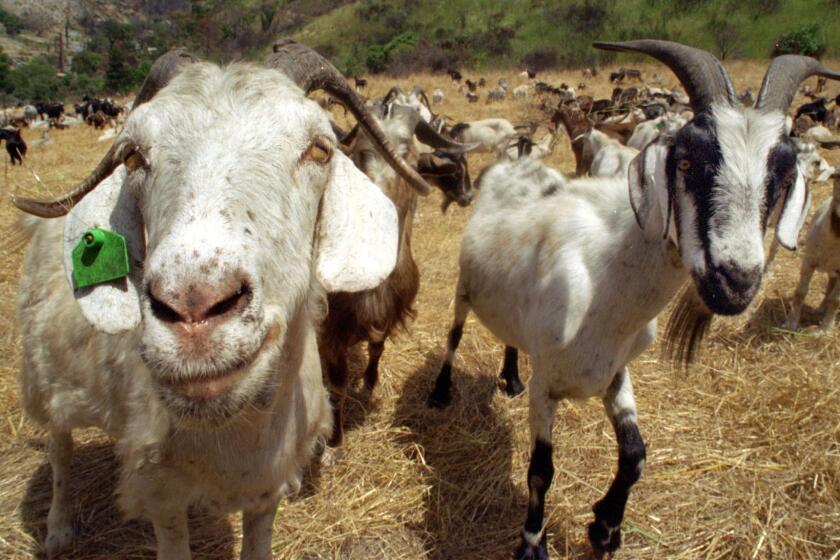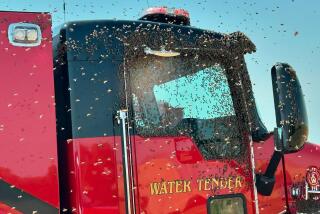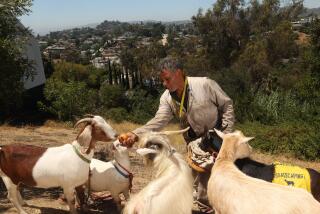West Sacramento turns to goats in its time of weeds

Why did the goats cross the road? In West Sacramento, they crossed Jefferson Boulevard to clear weeds and grass along the Clarksburg Branch Line Trail. The effort was part of the city’s wildfire prevention strategy.
- Share via
Just ahead of fire season, the residents of West Sacramento welcome several hundred goats for a bite to eat. Since 2014, hundreds of the animals have descended on the city to chomp down on wild vegetation in an effort to help curb the spread of wildfires.
The goats arrived this year in early March, and just like a musical act coming through town, they have their own tour schedule for fans to track where they head next.
In previous years, the city hosted a goat selfie contest, but because of the pandemic, the fan fest had to be tamped down to reduce the risk of potential coronavirus spread in large crowds.
Still, the goats’ annual visits bring a sense of calm to the city; compared to weed whackers and lawnmowers, the animals’ chewing is a bit more quiet.
“Sometimes, I’ll go out on a lunch break, and just sit and soak up the goats,” West Sacramento city spokesperson Paul Hosley said when reached by phone Friday. “The community loves it when the goats are in town.”
In tiny Nevada City, a Gold Rush town in Northern California touting a population of 3,100, folks are big on a novel idea to fight the increasing threat of wildfires: calling in the goats.
Students take field trips to the areas where the goats happily munch on overgrown grasses, and people from nearby cities drive in to visit the animals, Hosley said.
This year, 400 goats are in town, eating the wild vegetation along the Sacramento River in areas too difficult to reach with heavy machinery. The goats can clear about 2 acres a day and typically chew the high grass down to just about 4 inches, Hosley said. The goats will be along the Barge Canal and Clarksburg Branch Line Trail before relocating at South River Road and the Honda Hills to finish out the month.
Goats are used as a green alternative to reduce vegetation around urban settings ahead of fire season, according to Tim Arrowsmith, whose company, Western Grazers, rents out the goats. Depending on rainfall during a year, which determines vegetation growth, up to 1,000 goats could be sent out to clear an area.
“They’re able to set up and eat pretty quickly. They get going all summer long,” Arrowsmith said from Blue Tent Farms in Tehama County.
Arrowsmith has sent his goats as far south as San Diego and Moreno Valley to help clear excess growth. They don’t mind the long rides, he said.
“If they’re being loaded up onto the portable panels and onto the trucks, then they know that they’re going to somewhere with greener grass,” Arrowsmith said.
In their offseason, the goats get to rest, recreate and procreate. Then the grazing season starts back up again around October.
The city Tuesday unveiled the newest weapon in its arsenal of fire-fighting equipment: a herd of goats.
The idea has been used elsewhere in California.
For decades, Laguna Beach has launched a herd of goats to feast on the city’s canyon slopes in an effort to reduce the threat of brush fires.
In 2018, the Irvine Ranch Conservancy used the animals in its efforts to restore native grasses to the area.
And in 2019, Nevada City, Calif., launched a crowdsourcing campaign called “Goat Fund Me” to raise money to pay local ranchers to use their goats in a prescriptive grazing project on city-owned land.
The grass buffet is coming even as most of the state is in drought conditions after a bone-dry start to 2022. According to the U.S. Drought Monitor, over 90% of California is experiencing severe drought conditions, and nearly 40% of the state is seeing extreme drought conditions.
Arrowsmith said he expects his services will be needed further in the coming fire season as more dried-out vegetation will mean more fire hazards.
“A lot of fire prevention is making sure that people create defensible spaces around their homes and properties,” he said.
More to Read
Sign up for Essential California
The most important California stories and recommendations in your inbox every morning.
You may occasionally receive promotional content from the Los Angeles Times.












